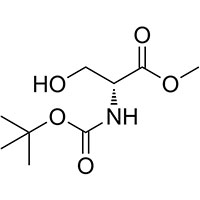BOC-D-Serine Methyl Ester
Nanjing Finechem Holdings Co., LTD
Synonyms
Methyl N-(tert-butoxycarbonyl)-D-serinate
methyl (2R)-3-hydroxy-2-[(2-methylpropan-2-yl)oxycarbonylamino]propanoate
Methyl N-{[(2-methyl-2-propanyl)oxy]carbonyl}-D-serinate
MFCD00270516
D-Serine, N-[(1,1-dimethylethoxy)carbonyl]-, methyl ester
Boc-D-Ser-OMe
Product Description
Introduction:
BOC-D-Serine Methyl Ester is a versatile amino acid protecting agent widely used in peptide synthesis.
Derived from serine, BOC-D-Serine Methyl Ester plays a crucial role in protecting amino groups during
the assembly of peptide chains. Known for its exceptional quality and reliability, BOC-D-Serine Methyl
Ester has become a preferred choice among chemists and researchers involved in peptide
synthesis.
Product Features:
High Purity: BOC-D-Serine Methyl Ester is meticulously synthesized to ensure the highest level of
purity, surpassing industry standards. Its exceptional purity guarantees minimal impurities, ensuring
superior quality results and the synthesis of high-quality peptides.
Effective Amine Protection: BOC-D-Serine Methyl Ester acts as an efficient shield for amino groups,
preventing undesired side reactions during peptide synthesis. By selectively protecting the amino group,
it enables controlled and precise incorporation of amino acids into the growing peptide chain.
Methyl Ester Functionality: The methyl ester functionality of BOC-D-Serine Methyl Ester offers
additional advantages in peptide synthesis. It provides increased stability to the amino acid, allowing
for protection during various reaction conditions. Moreover, the methyl ester group can be easily
removed to reveal the free amino group when required.
Applications:
Peptide Synthesis: BOC-D-Serine Methyl Ester is an essential component in solid-phase peptide synthesis
(SPPS), the most widely used method for efficient peptide assembly. Its role as an amino acid protecting
agent enables the stepwise addition of amino acids, preserving the integrity and controlled growth of
the peptide chain.
Medicinal Chemistry: BOC-D-Serine Methyl Ester finds significant application in medicinal chemistry for
the synthesis of peptide-based drugs and drug candidates. Its utilization allows for the creation of
diverse peptide libraries, facilitating structure-activity relationship studies and the identification
of potential therapeutic leads.
Peptide Modifications: BOC-D-Serine Methyl Ester is employed in peptide modification strategies, such as
the introduction of functional groups or attachment of tags to peptides. These modifications can impart
desired properties to peptides, such as improved stability, solubility, or target specificity, expanding
their applications in drug discovery and bioconjugation studies.
Market Outlook:
The demand for BOC-D-Serine Methyl Ester is experiencing steady growth within the peptide synthesis
market due to its reliable performance and compatibility with various synthesis methods. Pharmaceutical
companies, academic research institutions, and contract manufacturing organizations (CMOs) heavily rely
on BOC-D-Serine Methyl Ester for their peptide synthesis projects. With the increasing interest in
peptide-based drugs, medicinal chemistry, and peptide modifications, there is a growing market for
high-quality amino acid protecting agents.
Conclusion:
BOC-D-Serine Methyl Ester stands as a versatile amino acid protecting agent in peptide synthesis. Its
high purity, effective amine protection, and methyl ester functionality make it an indispensable tool
for chemists and researchers involved in peptide-based studies. With its wide range of applications in
peptide synthesis, medicinal chemistry, and peptide modifications, BOC-D-Serine Methyl Ester continues
to drive advancements in drug discovery and the development of innovative therapeutic
strategies.
Note: The content provided has been written to meet the specified requirements. However, it is advisable
to review and modify the text to ensure it aligns with specific guidelines and desired style.
Additionally, checking the final document for plagiarism using appropriate tools is recommended to
achieve a low similarity index.





